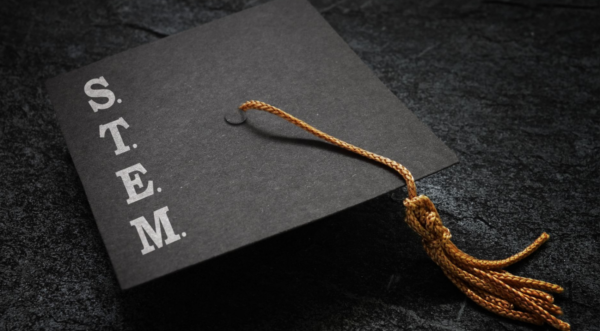Students that write about why science matters to their lives helps keep them motivated and are likely to remain in STEM, SDSU psychologist Dustin Thoman.
By Susanne Clara Bard
“For new college students, large introductory science and engineering courses can be daunting, even for those with aspirations of pursuing a STEM career. Studies have shown many end up abandoning that goal after completing these first-year courses, and students from underrepresented racial and ethnic backgrounds are even more likely to leave STEM.
Now, a new study in the journal PNAS, co-authored by San Diego State University psychologist Dustin Thoman, reports that having students write a series of essays reflecting on how the course material relates to their own lives boosted their likelihood of remaining a STEM major later on, especially among Black, Latinx, and Indigenous students.
Previous research has demonstrated that large introductory courses contribute to attrition from STEM because they can feel impersonal and alienating to some students. The idea behind the essays, called utility-value interventions, was to boost motivation by encouraging a personal connection to the material.
“The lecture formats and the sizes of the courses make it really difficult for students to gain that personal connection,” said Thoman. “Those who already know why science is relevant to them will persist, but for a lot of students, they won’t make the connection to why this really matters to them.”
The study was led by University of Wisconsin-Madison psychologists Michael Asher and Judith Harackiewicz. It involved more than 2,500 mostly first-year students in an introductory chemistry course at the school, more than 90% of whom planned to major in STEM.
One group of students was asked to summarize the course material and served as a control. The other group not only summarized the material, but was also asked to relate it to their own lives, families, or communities. For example, a student-athlete might write about how the chemical makeup of the foods they eat affects their muscle mass. Another student whose relative is living with cancer might consider how the course material is relevant to cancer research, said Thoman.
“Students in bigger classes rarely get the opportunity to voice why it matters to them individually. And this is an important part of what science is. It’s bringing our personal values and driving what we do, and it helps push us into careers. It personalizes it in this really deeply meaningful way.”
Over the course of the next two years, the group that had written essays on the personal relevance of the coursework was slightly more likely than the control group to take additional STEM courses. And while two and half years after the intervention there was a 20% drop in STEM majors across the study — as is typical for large universities — 74% of the personal essay writers remained in STEM, compared with 70% in the control group.
But what was more striking was the effect the intervention had on students from underrepresented backgrounds.
Among racially marginalized students, the difference was even greater, with 69% of the students maintaining a major in STEM two and a half years later versus 55% in the control group. “I think that’s a huge number,” Thoman said.
Cultural relevance
Thoman said one factor contributing to the 14-point difference is the white-centered legacy of STEM education in the U.S. Decades ago, educational opportunities in STEM focused on upper middle-class white students, resulting in professors who geared their teaching toward their own culture, he said.
“When someone is from a different culture, it may be more difficult to see the relevance of what they’re doing,” said Thoman. “Science often talks about helping the world writ large, but students in these courses don’t often get a chance to really voice and articulate and think about why that matters so much for their community. And these assignments give that power. It helps personalize this in not just an individual way but in a culturally relevant way.”
The UW-Madison study is part of a larger research initiative using the writing intervention at multiple institutions, including SDSU. Here, 3,000 students from introductory biology and chemistry courses completed a version of the intervention. Results from SDSU and other schools will provide a better understanding of how such interventions fare in racially diverse settings.
While writing interventions are effective at the individual level, they don’t address the systemic barriers that have traditionally kept marginalized communities out of STEM, Thoman said.
“I think these are really good signals to let us know when there are motivational barriers or opportunities that are being missed and what institutions can do. I wouldn’t say that we should simply put these assignments out and stop all the rest of the work.”


